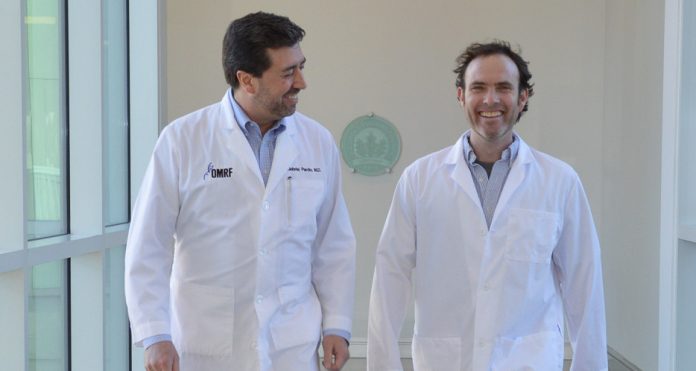A paper published in the Journal of Immunology provided a landmark moment in translational medicine for a pair of scientists at the Oklahoma Medical Research Foundation.
The paper marks the first published collaboration between Robert Axtell, Ph.D., a research scientist, and physician Gabriel Pardo, M.D., who combine their expertise to shed new light on multiple sclerosis, which is an inflammatory, degenerative disease of the central nervous system.
The two scientists’ effort focused on understanding the mechanisms of disease in MS and why specific treatment strategies do or do not respond by targeting specific immune cells. The project has been roughly a year in the making.
“It could prove to be a watershed moment for us,” said Axtell, an assistant member in OMRF’s Arthritis and Clinical Immunology Program, who came to OMRF in 2013 from Stanford University.
Since opening its Multiple Sclerosis Center of Excellence in 2011, OMRF has set out to provide a unique opportunity for MS researchers to collaborate with clinicians to better understand and treat the disease. The clinic allows for evaluation and care of patients where physicians learn firsthand what is or is not working or what needs to be addressed.
With clinical research housed in the same location as basic research, an open line of communication forms, allowing ideas to grow. This rare setup was used to investigate patient response to a popular MS therapy by using both human samples and mouse models.
“This consummates the purpose of having a clinical component to OMRF’s operation,” said Pardo, who is the director of the MS center and treats more than 2,000 MS patients. “We have a large population of individuals with a well-characterized immune-mediated disease that feeds into the strengths of the institution in basic autoimmune research. This is the first step in many to come.” The paper represents a milestone in OMRF’s efforts to accelerate translational medicine, a discipline that takes what Pardo refers to as a “bench-to-bedside” approach. By enabling researchers and clinicians to work closely with one another and share findings, it expedites the speed with which patients can receive new treatments.
In the new paper, Axtell and Pardo show that a particular MS medication, interferon beta, alters immune cells in a way that can help to suppress the disease and its symptoms.
Scientists do not fully understand how this specific mediation works in people suffering from MS, but Axtell said these new findings will help shed light on this question. The new information also allows clinicians at OMRF and elsewhere to look for potential markers in patient response so they can tailor treatments accordingly.
Judith James, M.D., Ph.D., leader of OMRF’s autoimmune disease research efforts, is encouraged by the findings.
“Patients in OMRF’s MS Center of Excellence have been kind enough to allow us to collect extra samples just so these types of studies can be done,” said James, who holds the Lou C. Kerr Endowed Chair in Biomedical Research. “By providing samples and their clinical information, partnered with philanthropic and National Institutes of Health financial support, we hope this will be just one of many productive collaborations to occur in multiple sclerosis clinical research.” Ultimately, said James, “The goal is that these and related studies will help improve the lives of patients with these diseases.”













